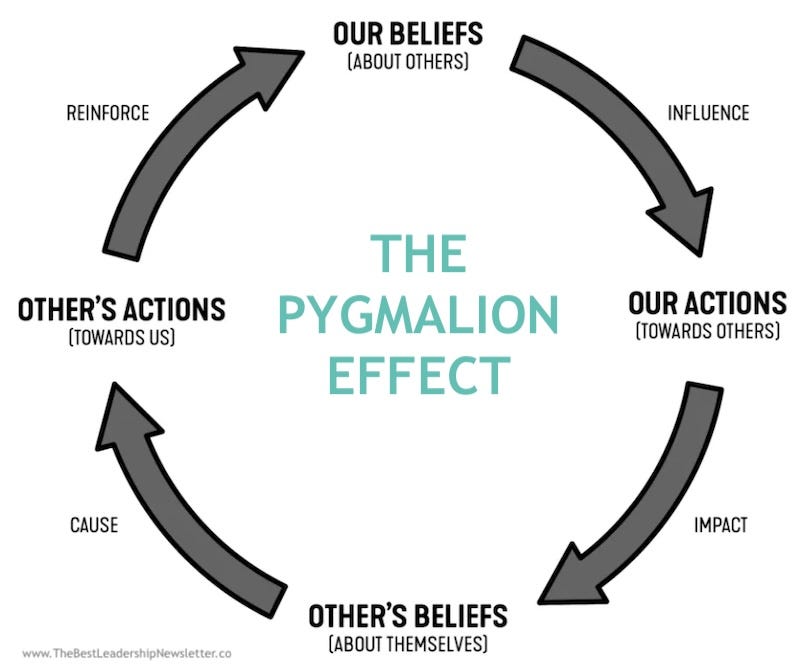316. Your Underperforming Employee Isn't Failing, You Are.
Your expectations shape reality, whether you realize it or not. Your underperforming employee isn't the problem, your self-fulfilling prophecy is.
⚠️ IMPORTANT NOTE
Thursday’s newsletter, “This Week In Leadership”, has a new name. It’s now called:
Life’s Leadership Lessons
That’s all. That’s the important note. Remember that on Thursday.
This is The Best Leadership Newsletter Ever, the most fun way to learn life’s leadership lessons, like the 6 addictions in the workplace.
In Greek mythology, there was this crotchety man named Pygmalion. I’ve always pictured him as a cross between Ebenezer Scrooge and Michelangelo, but in a toga.
Pygmalion had trouble dating, mostly because he was mean and hated women. Plus, there weren’t a lot of dating apps back in 10,000 BC.
One day, he decided he had enough with humanity and began to sculpt an ivory statue of his perfect woman.
The statue he created was so beautiful and so lifelike that he fell in love with it. For real love, not just like, “oh look at the cool thing I created” type of love.
He gave the statue a name (Galatea), he talked to her, dressed her, even kissed her, which is kinda creepy, but it was Ancient Greece and who knows what was happening back then.
Eventually, after treating the statue as if it were a real human, it came to life. It became a real human.
Keep that story in the back of your mind. It’s gonna be important in a minute.
But first, we need to time-travel out of Ancient Greece and into the 1960s.
The Expectation Of High Performance
Robert Rosenthal and Lenore Jacobson were two researchers interested in improving education. In 1968, they conducted an experiment to better understand the relationship between a teacher’s behavior and a student’s performance.
Here’s what they did.
At the beginning of the school year, they randomly selected a bunch of students and told the teachers that these students had taken a Harvard test and had been identified as “intellectual bloomers”. In other words, they claimed the students had a higher potential for learning than the other kids.
In reality, there was no difference between that group and the rest of their classmates. All Rosenthal and Jacobsen did was create a perceived difference.
Lo and behold, by the end of the school year, the IQ of the “intellectual bloomers” increased meaningfully more than the other kids.
Go figure.
What the researchers discovered was that the teachers treated kids differently simply because they believed they were higher performers.
Whether consciously or not, they gave the “intellectual bloomers” more attention, more encouragement, and harder challenges.
In the end, the expectation of their high performance became a self-fulfilling prophecy.
This is now known as the Pygmalion Effect.
See, I told you the crotchety sculptor’s story would come back around.
The Pygmalion Effect
The Pygmalion Effect happens everywhere, all the time. It especially plays a major role in the workplace - and you probably don’t even realize it’s happening.
But we’re about to change that.
You’re welcome.
What I want you to do right now is think about your present and past employees - the good ones and the not-so-good.
Got some people in mind?
Good. Now consider this:
Did the ones you expected to perform well meet your expectations?
Did the employees you thought would fail eventually fail?
Did any of the poor-performing employees turn things around and become high-performers?
Assuming your answers are some version of “yes, yes, no”, what I’m trying to say is that the failure of your low-performers wasn’t necessarily because they were incapable. It was because you didn’t treat them the same way that you treat the high achievers.
You’re probably trying to think of all the ways that I’m wrong. But I’m not.
So stop trying.
I see the Pygmalion Effect all the time in my leadership coaching business.
Your Underperforming Employee
I’m often brought into a company to help with underperforming employees - or dysfunctional teams. Same same.
One of my first questions is always this:
Do you actually want your employee(s) to succeed, or do you just want to get rid of them? Because if you want them to succeed, you need to change your perception of them.
Then I explain the four phases of how the Pygmalion Effect manifests itself at work.
Let me explain them to you.
The 4 Phases Of A Self-Fulfilling Prophecy
Every interaction with your employees follows a four-phased cycle that creates the self-fulfilling prophecy.
1. Your Impression
You create an impression of the employee’s capabilities. Whether it’s positive, negative, or somewhere in between, you always formulate an impression.
2. Your Behavior
Your impression influences how you behave with them. You most likely don’t even realize the nuances of your behavior.
3. Their Perception
How you behave with them impacts their self-perception and self-confidence. You will either raise it or lower it based on your behaviors from steps 1 and 2 above.
4. Their Actions
Their actions will be influenced by their self-perception, which is influenced by your behavior, which is influenced by your impression. If they feel like you don’t think they’re good, they will act with more hesitancy. But if you think they’re a high performer, they will be more confident and creative.
In the end, their actions simply perpetuate and strengthen your impression of them.
Here’s what this looks like in a not-quite-so-fancy chart.
You know what, let me give a common example I see in my coaching business.
Let's say you have an employee who tends to always argue with you. When you ask them to do something, they unload all the excuses why they shouldn’t or can’t.
Because of this, you don’t like interacting with them as much as with your other employees, so you limit your time with them.
Your meetings are shorter.
You give them fewer opportunities.
You get frustrated more quickly.
But because you treat them that way, they feel like you don’t trust or believe in them. So it perpetuates their behavior, and they push harder on you for attention.
In their mind, they’re just trying to get the same opportunities as others.
But in your mind, they’re proving to be the combative person you thought they were in the first place.
Eventually, the relationship will deteriorate. The employee won’t succeed because they’re frustrated that you don’t give them a fair chance. At the same time, their actions make you increasingly more frustrated until it all explodes.
It’s a vicious cycle.
Has this happened to you?
I’m guessing it has.
It happens in every single company.
How To Get Out Of The Self-Fulfilling Prophecy
Here’s my challenge to you:
Think of two employees at your company - one who you think is a high performer and one a low performer.
For the next week, pay close attention to how you are communicating with each of them.
What different words are you using for each?
How are you acting and speaking differently?
Do you look the high performers in the eyes more often?
Do you acknowledge them more frequently?
Do you give them more growth opportunities?
Once you have a good understanding of the nuances of your behavior, I want you to change your perception.
Dare to believe that the low performers can be high performers.
Believe that everybody on your team can excel.
Instead of sabotaging anybody, raise the bar for everybody. Expect more. Set higher standards and give them all the equal freedom to excel.
Do it.
I dare you.
Let me know how it goes. Send me an email here or leave a comment.
You’re Better Than This
Pygmalion never fully realized how much of a jerk he was. The good news is that you’re better than him. I know you are. I see you.
Once you believe in everybody on your team in an equal way, you’ll be amazed at how much better they can be. Trust me, I see it all the time.
So if your employees aren’t growing, maybe it’s not them that are failing.
It’s probably you.
I’ll quickly transform you and your team into the highest-performing people in your company.
Learn more
Subscribe to The Best Leadership Podcast Ever
YouTube
Apple
Spotify
or your favorite podcast player.
Leading Starts With Following
⛓️ Follow me on LinkedIn
Here are some other options:
🎥 Subscribe on YouTube
⏰ Follow me on TikTok
📖 Follow me on Facebook
📷 Follow me on Instagram
🅧 Follow me on X (Twitter)








